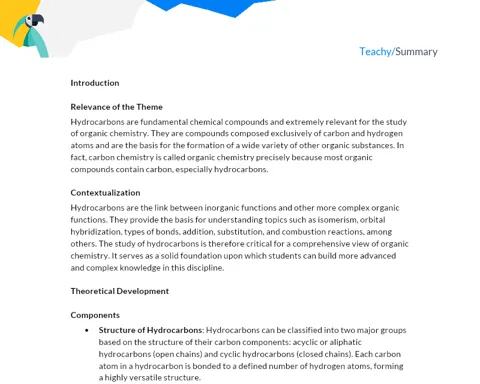Exploring the Acidity and Basicity of Organic Compounds in Applied Chemistry
Objectives
1. Identify organic compounds as acids or bases based on their chemical structures.
2. Classify organic compounds in order of acidity and basicity, using concepts from organic chemistry.
3. Understand the relationship between molecular structure and acid-base properties.
Contextualization
Organic compounds are found in various products we use in our daily lives, such as medications, food, and cleaning products. Understanding the acid-base properties of these compounds is essential for various fields, including the pharmaceutical industry, where acidity or basicity can influence a drug's effectiveness, and environmental chemistry, where acidity can affect water and soil quality. By understanding these properties, we can develop better products and solutions to environmental problems. For example, the acidity of vinegar is due to acetic acid, an organic compound, while caffeine, present in coffee, is a weak base.
Relevance of the Theme
Understanding the acid-base properties of organic compounds is fundamental for various industries, such as pharmaceuticals, which rely on these properties to develop effective medications. In the food industry, controlling acidity is crucial for preserving food products. In environmental chemistry, monitoring the acidity of organic compounds is vital for protecting the environment. Therefore, this topic is highly relevant to ensuring the safety, effectiveness, and sustainability of various products and processes in the current context.
Definition of Acidity and Basicity in Organic Compounds
Acidity and basicity are chemical properties that determine a substance's behavior in aqueous solution. In organic compounds, acidity is often associated with a compound's ability to donate a proton (H+), while basicity relates to the ability to accept a proton.
-
Acidity: The ability of a compound to donate a proton (H+).
-
Basicity: The ability of a compound to accept a proton (H+).
-
Importance: Crucial for understanding chemical reactions and behaviors in solutions.
Molecular Structure and Its Influence on Acidity or Basicity
The molecular structure of organic compounds, including the presence of functional groups, directly influences their acid-base properties. Groups such as carboxyls tend to increase acidity, while amino groups increase basicity.
-
Carboxyl Groups: Increase the acidity of compounds.
-
Amino Groups: Increase the basicity of compounds.
-
Relevance: Molecular structure determines how compounds react in different environments.
Comparison of Different Organic Compounds in Terms of Acidity and Basicity
Comparing different organic compounds allows for a better understanding of their acid-base properties. For example, carboxylic acids are generally more acidic than alcohols and phenols, while amines are weak bases.
-
Carboxylic Acids: More acidic than alcohols and phenols.
-
Amines: Weak bases, but more basic than alcohols.
-
Application: Essential for the classification and proper use of compounds in different industries.
Practical Applications
- Development of medications: Acidity and basicity influence the absorption and effectiveness of drugs.
- Food preservation: Controlling acidity is fundamental to prevent spoilage and prolong shelf life.
- Industrial waste treatment: Monitoring acidity helps neutralize hazardous substances and protect the environment.
Key Terms
-
Acidity: The ability of a compound to donate a proton (H+).
-
Basicity: The ability of a compound to accept a proton (H+).
-
Functional Group: A specific group of atoms within a molecule responsible for the characteristic chemical reactions of that molecule.
-
pH Indicator: A substance that changes color depending on the pH of the solution, used to measure acidity or basicity.
Questions
-
How does the molecular structure of organic compounds influence their acid-base properties?
-
In what practical situations can the acidity or basicity of an organic compound be crucial?
-
What environmental impacts can result from the imbalance of acidity in waters and soils?
Conclusion
To Reflect
Understanding the acid-base properties of organic compounds is fundamental for various fields of knowledge and industry. The molecular structure of an organic compound directly influences its acidity or basicity, which in turn affects its practical applications. For example, in the pharmaceutical industry, the acidity of a drug can determine its effectiveness and absorption in the body. In the food industry, controlling acidity is essential for food preservation. Additionally, in environmental chemistry, the acidity of compounds can impact water and soil quality, affecting entire ecosystems. Therefore, by mastering these concepts, we are better prepared to develop innovative and sustainable solutions that can improve the quality of life and protect the environment.
Mini Challenge - Practical Challenge: Testing Acidity and Basicity
In this challenge, you will test the acidity and basicity of different organic compounds found at home, using simple pH indicators.
- Gather samples of common household products that you suspect are acidic or basic (e.g., lemon juice, vinegar, baking soda, soap).
- Prepare small containers with each of these samples.
- Use litmus paper or another available pH indicator to test the acidity or basicity of each sample.
- Record the results and compare the acidity and basicity of the tested compounds.
- Classify the compounds in order of acidity and basicity based on the results obtained.



